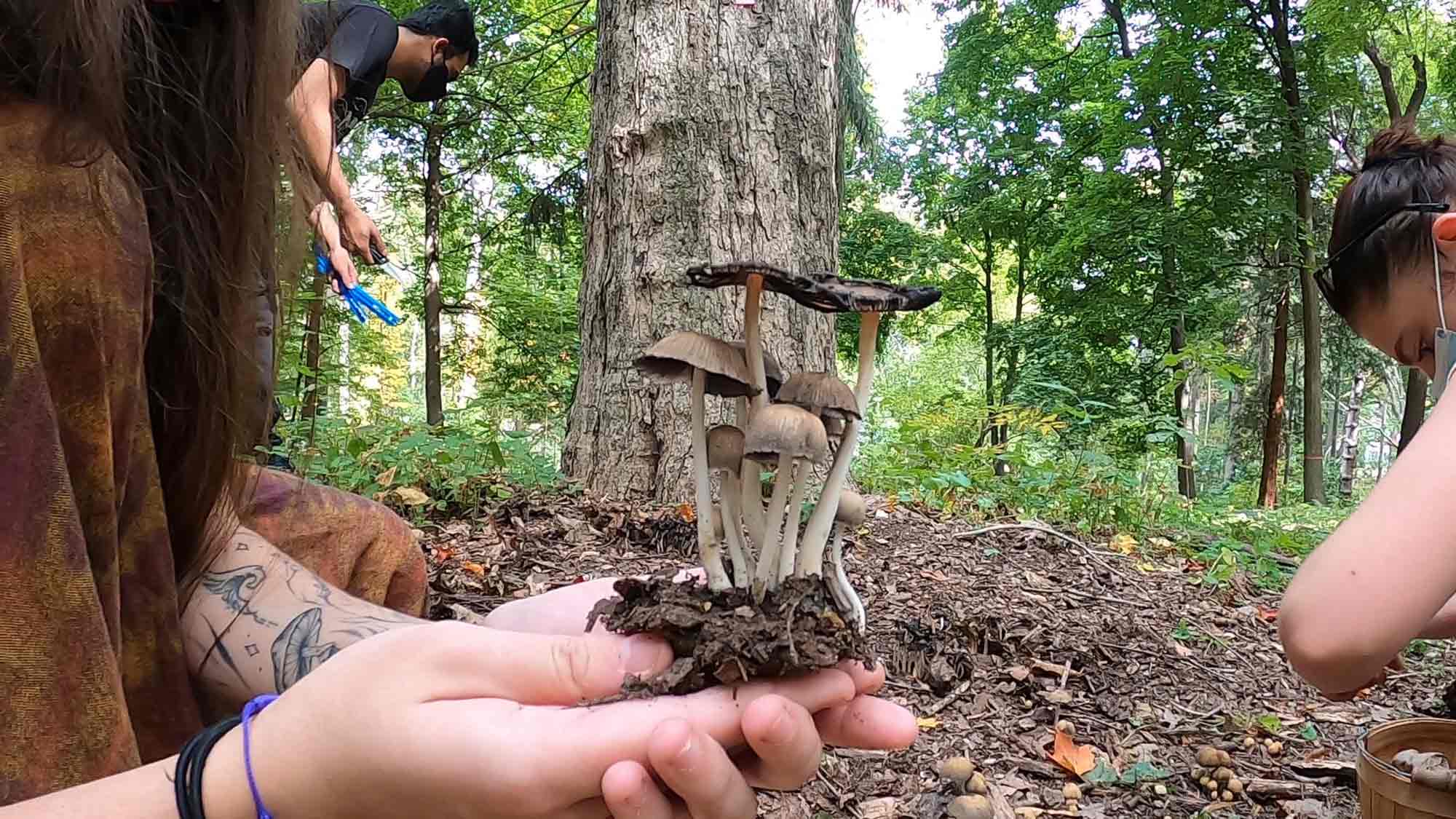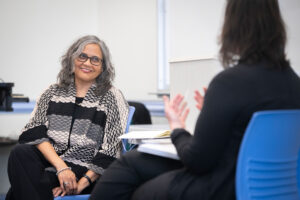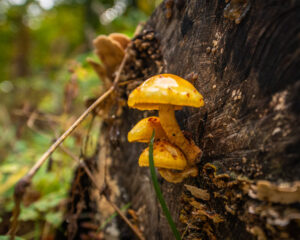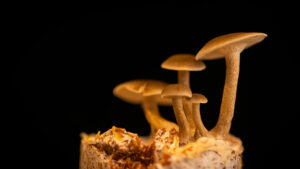Before the post-apocalyptic game and TV series “The Last of Us,” we might not have equated fungi with killer zombies. Instead, over thousands of years, we have looked to fungi — usually in the form of mushrooms — for food, medicine, storytelling, and spiritualism.
There was The Iceman we now call Ötzi, discovered by hikers on the Austria-Italy border in 1991, who lived and died more than 5,000 years ago. Along with his copper axe, knife, arrows, and baskets, Ötzi carried two species of wood-decaying mushrooms: the tinder conk (Fomes fomentarius), a tough, hoof-shaped bracket fungus, and the birch polypore (Fomitopsis betulinus), both of which can be found today.
And there was Fungus Man, accompanied by the trickster Raven, key characters in the Haida people’s creation story in the Pacific Northwest.
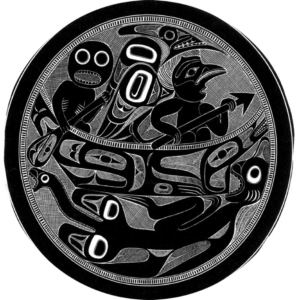
Drawing from a carving by Charles Edenshaw in the late 1800s depicting the Haida myth of the origin of women. Credit: Field Museum of Natural History, Chicago
They are just two of the many examples that students encounter in Plants, People, and Fungi, an advanced course focused on humans’ age-old relationships with flora and funga. New to Clark this spring, the class is taught by mycologist David Hibbett, the Andrea B. and Peter D. Klein ’64 Distinguished Professor of Biology, and ethnobotanist Morgan Ruelle, associate professor in the Department of Sustainability and Social Justice.
“I’m having a tremendous amount of fun teaching the course,” says Hibbett, who joined Clark in 1999 and is now a world-renowned expert on the evolutionary biology of mushroom-forming fungi. “It’s plants and fungi. It’s basic botany and mycology. And it’s ethnobotany and ethnomycology. So it’s very interdisciplinary.”
“We can look at the use of plants and fungi as food from biochemical, evolutionary, taxonomic perspectives or from cultural, social, economic perspectives. To develop a deeper understanding, we need multiple perspectives.”
Ruelle brings expertise on how Indigenous and other place-based ecological knowledge systems can be combined with scientific research to develop sustainable solutions. Currently, he is working with scientists and farmers in Ethiopia to study how their longtime use of traditional grain mixtures could be expanded to adapt to climate change in Africa.
“We can approach the study of human-plant-fungal relations from many different disciplinary perspectives, and I think that David and I are demonstrating that in each class,” says Ruelle, who met Hibbett after joining Clark in 2018.
“We can look at the use of plants and fungi as food from biochemical, evolutionary, taxonomic perspectives or from cultural, social, economic perspectives,” he says. “To develop a deeper understanding, we need multiple perspectives.”
Some of those perspectives have been provided by guest speakers like Thidi Tshiguvho, Ph.D. ’08, executive director of Worcester Roots, a local nonprofit, who discussed “the use of plants and fungi in Indigenous medical systems, including linkages between spirituality, traditional healing, and more conventional medical practice,” according to Ruelle. “She provided insights into how different worldviews shape people’s understanding of what plants and fungi do when they heal us.”

Recommended readings include best-selling books like Michael Pollan’s “Botany of Desire: A Plant’s-Eye View of the World,” Merlin Sheldrake’s “Entangled Life: How Fungi Make Our Worlds, Change Our Minds and Shape Our Futures,” and Robin Wall Kimmerer’s “Braiding Sweetgrass: Indigenous Wisdom, Scientific Knowledge, and the Teachings of Plants,” and M. Kat Anderson’s “Tending the Wild: Native American Knowledge and the Management of California’s Natural Resources,” along with additional texts on ethnobotany and enthnobiology.
Hibbett dives into the biochemical properties of plants and fungi, and their scientific and evolutionary history. An ongoing theme in the course has been humans’ “give and take” with plants and fungi, Ruelle says.
“We often describe it as co-evolutionary. It’s not only that we domesticate plants, but Michael Pollan has written that the plants also domesticate us,” he says. “We shape the plants genetically so that they better serve our needs, and sometimes they become dependent on us because we provide protection and promote their reproduction.
“On the other hand, our cultures and ways of knowing are really shaped by plants and how we use them for food, for health, for energy. There’s this mutual benefit in all these relationships that emerges strongly as we go through the course.”
Yet, Indigenous knowledge of plants and fungi also has been exploited, according to Hibbett.
“Taxonomy is inextricably connected to the history of colonization because so much of what we know about plants, fungi, and animals outside of North America and Western Europe really blossomed during the 19th century,” he explains, “when you had naturalists going around the world collecting the riches of the planet and bringing them back to museums and botanical gardens and zoos in Europe, principally, and then later in North America.”
The class’ final assignment includes researching, presenting, and writing about a topic of choice; the articles will be published on a publicly available blog site. Many of the students have been interested in the medical and health applications of plants and fungi, such as the use of Psilocybe cubensis, or magic mushroom, for mental health and spiritual wellness.
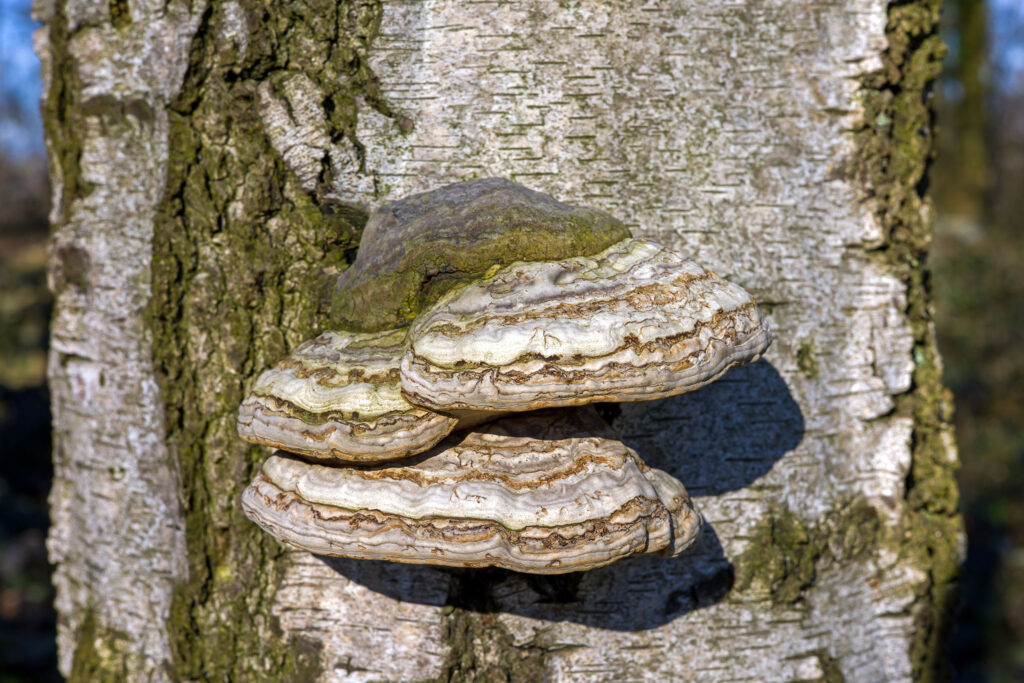
And that circles back to Ötzi and his mushrooms. Why was this neolithic man carrying two different fungi?
The fruiting bodies of Fomes fomentarius are as hard as wood, but they can be pulled apart and stretched to make a felt-like material, called amadou, for hats and clothing. The fungus smolders for a long time after being lit on fire; hence the common name tinder conk. Ötzi carried flints along with his pieces of Fomes fomentarius, suggesting that he used the mushroom to start fires, according to Hibbett.
It is less clear why Ötzi carried the birch polypore, he adds, but its use might have been medicinal.
“We do not know for certain what Ötzi was using the fungus for,” Hibbett says. “Maybe he was using it as medicine. There is some evidence that extracts from this fungus might have antimicrobial properties.”
Now, the mushroom is widely marketed for medicinal purposes. “It’s held up as an example of this ancient wisdom,” Hibbett says, “but, in my view, that is tremendously exploitive. The people selling medicinal mushrooms make big health claims, but the science is not there yet.”


